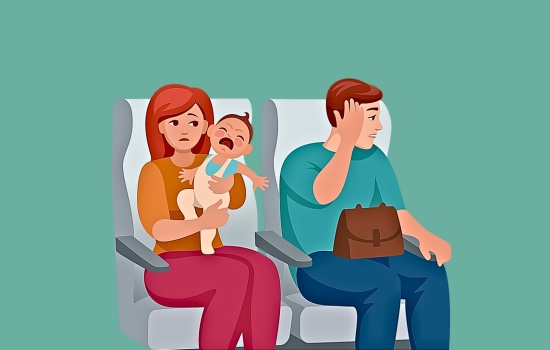It’s generally recommended that babies avoid plane travel until they’ve received their 2-month vaccines.
When you DO get the green light to travel by airplane with your baby, know that it will be a completely different experience than flying by yourself. Gone are the days of browsing through magazines at the newsstand, traveling with one piece of luggage, and getting some peace and quiet to watch a movie on the plane. Welcome to your new reality of hauling car seats, travel cribs, clothes, breast pumps, burp cloths, diapers, you name it, to the airport for a measly 2-day trip.
Here are 10 Tips to Help You Navigate the (Not As) Friendly Skies With Your Baby:

1. Lower Your Expectations.
Remember that your goal is to get from point A to point B without having a nervous breakdown. Keep your eye on the ball.
2. Travel at Off-Peak Hours When the Airport Isn’t Super Crowded.
This isn’t always an option, but it’s worth a try.
3. Consider the Flight Time as it Relates to Your Baby’s Schedule.
For Example, Is the Flight During Your Baby’s Naptime? This could be a good thing or a bad thing depending on your baby’s willingness to sleep in transit.
It’s Also Important to Be Mindful of When Your Baby Usually Eats. You can breastfeed on the down-low on the plane or bring extra pumped breast milk or formula with you.
4. If Your Baby is Formula Fed, Either Mix the Formula Ahead of Time and Store It In a Small Cooler OR Put Premeasured Scoops of Formula In the Bottle and Bring Bottled Water to Mix With It.
PediaTip: If you have some extra money lying around, spring for some “ready-to-feed” formula (which requires no mixing).
Remember:
- Prepared formula should be left out at room temperature for no more than 1 hour. After an hour, it should be discarded.
- Once your baby has had their fill of formula, any formula left over in the bottle should be thrown away because it now has your baby’s germs in it (from spit-back).
5. Bring a Bunch of Toys, Board Books, and Stuffed Animals on the Plane.
Put some old favorites in your carry-on bag PLUS a few new toys or books to pique your baby’s interest.
6. Consider Getting a Separate Seat for Your Baby (If It’s in Your Budget and They’re 6 Months or Older).
Although kids under 2 years of age have historically been allowed to fly for free in the arms of a parent, they’re better protected when restrained in an FAA-approved safety seat next to their caregiver (starting around 6 months of age).1
Insider Info: The FAA recommends that children under 40 pounds use a safety seat. Check your car seat to see if it has an FAA-approved safety sticker. Children under 20 pounds should travel in the rear-facing position, whereas kids 20 pounds & above can ride in the forward-facing position.2
7. Try Not to Care (Too Much) About the Eye Rolls From Your Fellow Passengers.
Most people are understanding and kind. The rest can fly private next time.
8. Feed Your Baby During Takeoff and Landing to Help Equalize the Pressure in Their Ears (Especially If They Have a Cold or an Ear Infection).
9. Bring Hand Sanitizer and a Baby Blanket to Protect Your Little One Against Germs.
It doesn’t hurt to clean the tray table & the seat with a disinfectant wipe too.
10. Send As Much Stuff Ahead As Possible.
Send wipes, diapers, strollers (and more!) to your final destination, so you don’t have to drag them around with you. Thank you, Amazon Prime!
The Bottom Line
Although air travel with an infant has its challenges, it tends to be easier than air travel with a toddler.
Why? Because toddlers are in constant motion and like to run up and down the aisles and kick the seats in front of them.
Good Times!






